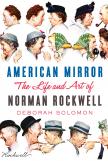Behind the Portraits
I once was loath to admit it, but I have always loved Norman Rockwell. Is it his smart sense of irony and playfulness, his loving attention to detail? Or is it just that I have poor taste? As a ponderous college sophomore newly “appreciating” the modern visual arts, I professed my loyalty to the likes of Kandinsky and Miró, and though I never publicly renounced Rockwell, I’m almost certain I’d have done so if pressed, citing his indifference to the social and cultural revolutions taking place around him. Deborah Solomon’s thoughtful—if a touch heavy-handed—biography of Rockwell made me glad it never came to that.
Beginning in the 1910s, generations revered Rockwell’s hundreds of covers for the popular Saturday Evening Post, works that bestowed on him celebrity status and made his work—along with that of Pollock and Warhol—among some of the most identifiable cultural products of 20th-century America. Though his range was significantly broader, Rockwell, a native New Yorker who retained his native accent until his death in 1978, became known as a chronicler of small town life. It was a reputation with which he was evidently uneasy, and he made a few earnest, though fretful and ill-fated, attempts to channel the spirit of artistic modernism. No, Rockwell finally concluded in his typically humorous and self-deprecating way, he was merely an illustrator, not an artiste.
It was just this identity as a mere illustrator that, beginning in the mid-1950s, induced influential critics to offer withering interventions, deriding Rockwell as a middlebrow entertainer and sentimental hack who lacked the “emotional appeal” of rising stars like Willem de Kooning and Robert Motherwell.
To what extent were these critics successful at changing how the public viewed Rockwell? They were successful enough that nearly four decades later, a naïf like me, anxious to project a sense of cultured refinement, felt it wise to keep his sympathies for Rockwell in pectore. And yet, as Solomon highlights, well-attended New York retrospectives in 1968 and 1971, along with the related sale of books and prints, proved his enduring appeal. Indeed, Rockwell’s “Saying Grace,” a 1951 work depicting a grandmother and grandson praying in a restaurant under the leering gaze of perplexed patrons, went for $46 million as recently as December 2013. Perhaps the critics missed the mark when it came to quantifying Rockwell’s “emotional appeal.”
Among the many attractive aspects of this book is Solomon’s searching exploration of the complex private life of her subject. Thrice married, Rockwell was a distant husband and an aloof father, a persnickety man unwilling to alter his routine and reluctant to abandon his studio, even as his second wife, Mary, descended into the cycle of depression and alcoholism that brought her untimely death. After having three children, he and Mary sailed to England to procure a quiet abortion in 1938, lest they add a fourth to their complicated lives. Later, we see Rockwell, an early adopter of antidepressants, become heavily reliant upon a string of therapists—including the eminent Erik Erikson, with whom he also developed a close friendship. Solomon covers all this and more without a hint of that brand of condescension that shakes its head at the hypocrisy of it all—a man whose work so often celebrated family connection and good cheer, yet whose private life often enough gave sparse evidence of these things.
Then there is the matter of Rockwell’s sexuality—a subject on which Solomon falters. From early on in his career, we learn, Rockwell developed a series of conspicuously intense friendships with younger men and prepubescent boys, artists and models with whom he appears to have spent an enormous amount of time over the years, often to the neglect of his wives. Though she believes Rockwell would have recoiled from any physical sexual encounter with males, she detects his sexual attraction both to men and boys and reads elements of suppressed/repressed desire into his work. It is not so much her interest in exploring Rockwell’s sexuality—maybe she is right, maybe not—that causes this aspect of the book to fall flat, but her overwrought attempts to expose in his paintings the evidence of this desire. Regardless, she does succeed in underscoring how Rockwell’s work ought to be examined through the lens of gender, given that it frequently affirms a robust and rascally ideal of boyhood and, at times, depicts women and girls as masculinized.
Solomon’s most useful insight is that Rockwell’s work is largely about the act—perhaps even the duty—of looking. He was notorious for requiring models to sit for torturously long stints as he meticulously documented every wrinkle around the eye, every vein of the hand, every crease in the garment. Time and again, he asked viewers of his work to study people who are themselves studying other people, framed by an intricate environment that itself cries out for careful scrutiny.
Pick a Rockwell at random: You will likely find in it an invitation to slowly drink in a world of details. Couldn’t we do worse amid our brisk and harried lives?
This article also appeared in print, under the headline “Behind the Portraits,” in the March 31, 2014, issue.








